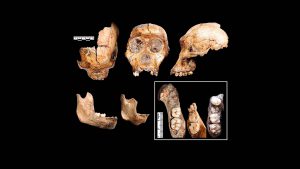
One of the more recent additions to the hominin family tree is Australopithecus sediba, named following discoveries made in South Africa at Malapa Cave. “Sediba” is a Lesotho word meaning “fountain” or “wellspring.” Au. sediba is dated to between 1.75 and 1.95 million years ago using biochronology (a relative dating method utilizing fossilized nonhominin animals), paleomagnetism (observing the record of Earth’s magnetic field preserved in magnetic minerals), and uranium-lead (a radioisotopic method that measures the amount of uranium that has decayed to lead in a geologic sample) techniques. Au. sediba has associated cranial (the skull minus the lower jaw) and postcranial (the skeleton minus the skull) remains showing a mosaic of primitive (shared with the ancestral form) and derived (different from the ancestral form) characteristics. This mosaic of features suggests links between Au. sediba and other species in the genus Australopithecus as well as similarities to species in the genus Homo. Au. sediba is important because it provides insights into hominin variation around the period when the genus Homo emerged.
The skull and dentition of Au. sediba display a mosaic of primitive features—in this case, similarities to other species in the genus Australopithecus—and derived features—in this case, features more closely resembling species in the genus Homo. Cranially, the features that link it to Australopithecus include a small cranial capacity (around 420 cubic centimeters), pronounced brow ridges, and enlarged tooth cusps (the pointed eminences on teeth) spaced close together. The discoverers of Au. sediba argue that, among the australopith species, it most closely resembles Australopithecus africanus, which they argue is its likely ancestor. Many differences between Au. sediba and Au. africanus, however, are evident; for example, the brain case of Au. sediba is much more vertical on its sides, the temporal lines (which mark the attachment of a chewing muscle that closes the jaw, located on the sides of your cranium) are widely spaced, its cheek bones are smaller, and its molars are long relative to their width. These features not only set apart this new species from other australopith species, but also link Au. sediba to species in the genus Homo.
The postcranial remains of Au. sediba, like the cranial and dental remains, show a mosaic of primitive and derived features. The body proportions of this species, for example, are like australopiths, in having retained relatively long arms, with somewhat elongated legs. The arm also retains large joint surfaces, which suggests this species retained some tree climbing ability. The shape of the pelvis, on other hand, is derived and resembles that of Homo erectus, in that the Au. sediba pelvis shows evidence of reorganization associated with energy-efficient bipedal walking and running like that seen in H. erectus (see H. erectus for details on its anatomy).
The scientists who discovered Au. sediba suggest this species is a transitional form between Au. africanus and the genus Homo. This has been criticized by other scientists who point out that the earliest dates for the genus Homo are around 2.4 million years ago—Homo rudolfensis predates Au. sediba by about 500,000 years, making it impossible that all populations of early Homo descended from Au. sediba. Additionally, some African H. erectus specimens are dated to around 1.8 million years ago, only about 100,000 years younger than Au. sediba, with features so derived that it is very unlikely that this species gave rise to them. These scientists suggest Au. sediba represents the termination of the Au. africanus line in South Africa and did not contribute to the genus Homo.
Because of the mix of primitive and derived features present in Au. sediba, scientists debate whether it should be attributed to the genus Homo or to the genus Australopithecus. Some scientists argue that because Au. sediba shares traits with members of the genus Homo not found in any australopiths species, it should be assigned to Homo. Others, however, argue rather than by individual traits, a genus should be defined by its overall adaptive strategy (how it moves around, acquires food, uses cognition, etc.). These scientists place Au. sediba within the genus Australopithecus because it retains a relatively small brain and primitive traits associated with climbing adaptation seen in other australopiths. This debate is an important one because, if Au. sediba is retained in the genus Australopithecus, its similarities to that genus might suggest that it is a transitional species perhaps transitional to a separate, South African Homo lineage. If Au. sediba is reassigned to the genus Homo (which is unlikely), it may instead represent a relatively early species in the genus and would suggest that at least some early Homo populations maintained very primitive postcranial skeletons and small brains, while possessing skulls that were otherwise very similar to later Homo species.